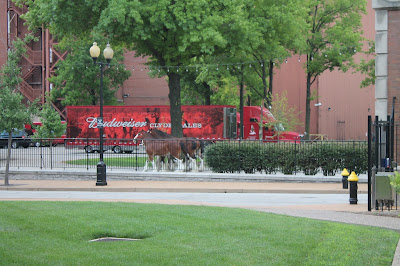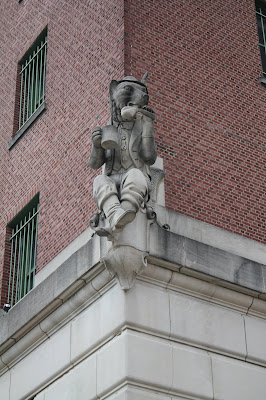 |
| A recently developed campground west of the Missouri River along a man-made lake and nice paved walking and biking trails that extend out from here into the surrounding areas. |
 |
| This property was owned by one of Daniel Boone's sons and it is here that he spent the last years of life. |
 |
| A display of small cannon fire. |
 |
| Ready...Aim...FIRE!!! Nice photography, Bob. |
Anheuser-Busch, St. Louis, Missouri - 2 July 2018
 |
| Disregard that we had both lived in St. Louis for many years, we had never taken a tour of the original A-B Brewery. |
 |
| The iconic A-B "Flying Eagle" logo. |
 |
| The official home of the Budweiser Clydesdales is this ornate brick and stained-glass stable built in 1885 on the 100-acre Anheuser-Busch Brewery complex in St. Louis. |
 |
| All the ladies housed here were outside but all the boys were inside. |
 |
| A couple of the Beer Wagons |
 |
| Anyone know what this wagon is for? Bob thinks it may be a barley wagon. |
 |
| The original clock tower built in 1891 is attached to the brewing house. Inside is ornate wrought-iron railing and hop vine chandeliers from the 1904 World's Fair. |
 |
| The sign says this is a photo opportunity so we took a picture. We have no idea what this giant sink was used for or why we would want a picture of it. |
 |
| Interior of the Brew House with its ornate wrought iron. |
 |
| The character is from a medieval French folk tale and is called Renard the Fox. The plant is still bottling the two most popular brands, Budweiser and Bud Light. |
 |
| The lobby of the Bevo Packaging Plant with the original tiles. |
 |
| Catching the trolley back to the Biergarten. |
 |
| Heading off for a few hours of genealogical research. |
 |
| Madison County Courthouse housing the marriage records from 1820, Deeds of Trust from the same time-frame and also wills. |
 |
| Ted Drewes has been selling frozen custard for over 80 years (about 1931) at the Grand location in St. Louis and currently has two locations, including this one on Chippewa. |

















No comments:
Post a Comment